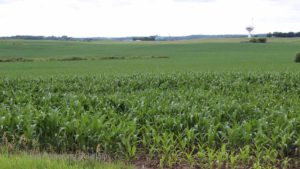Tokyo-based Arysta LifeScience Inc. has pulled methyl iodide, a fumigant for strawberries and other crops, from the U.S. market. There has been a furious debate over this chemical among consumer advocates and scientists.
 Methyl iodide is a fumigant pesticide called a “pre-plant biocide”, used to control soil-borne pathogens and weed seeds in strawberry fields. It was introduced to the U.S. market after methyl bromide was banned because it depletes the ozone layer. An international treaty in 1993 required the phase-out of methyl bromide by 2005.
Methyl iodide is a fumigant pesticide called a “pre-plant biocide”, used to control soil-borne pathogens and weed seeds in strawberry fields. It was introduced to the U.S. market after methyl bromide was banned because it depletes the ozone layer. An international treaty in 1993 required the phase-out of methyl bromide by 2005.
In 2010, in the last days of the Schwarzenegger administration, California approved the use of methyl iodide over objections of state scientists. The Department of Pesticide Regulation (DPR) in that state set exposure levels that were 120 times higher than its scientists recommended. The Bush administration approved methyl iodide for agricultural use in 2007 at even higher levels than set by the California DPR.
Animal lab tests showed methyl iodide causes thyroid cancer and miscarriages and is a neurotoxin that causes chronic, irreversible brain damage.
In 2011, a lawsuit was brought against Arysta by environmental groups including Earth Justice. The suit claimed the approval of methyl iodide violated the California Environmental Quality Act, the California Birth Defects Prevention Act, and the Pesticide Contamination Prevention Act.
Although the state of California required a large buffer zone between farms that used the chemical and residential areas, only one strawberry grower used the chemical last year.
While the EPA approved its use, a letter from 50 scientists, including five Nobel laureates, called the compound “one of the most toxic chemicals used in manufacturing.”
In that letter, the scientists make note of the fact that the EPA required documentation of the release of small amounts of methyl iodide used in research labs, while permitting the use of millions of pounds of the chemical in agriculture. Excerpts from that letter:
Alkylating Agents like methyl iodide are extraordinarily well-known cancer hazards in the chemical community because of their ability to modify the chemist’s own DNA, as well as the target molecule in the flask, leading to mutations that are potentially very harmful.
Because of methyl iodide’s high volatility and water solubility, broad use of this chemical in agriculture will guarantee substantial releases to air, surface waters and groundwater, and will result in exposures for many people. In addition to the potential for increased cancer incidence, U.S. EPA’s own evaluation of the chemical also indicates that methyl iodide causes thyroid toxicity, permanent neurological damage, and fetal losses in experimental animals. EPA’s exposure assessment suggests that the Agency is willing to accept exposures at levels that may cause these effects in humans up to five percent of the time near the application site.
We are skeptical of U.S. EPA’s conclusion that the high levels of exposure to methyl iodide that are likely to result from broadcast applications are “acceptable” risks. U.S. EPA has made many assumptions about toxicology and exposure in the risk assessment that have not been examined by independent scientific peer reviewers for adequacy or accuracy. Additionally, none of U.S. EPA’s calculations account for the extra vulnerability of the unborn fetus and children to toxic insults.
Finally, we are perplexed that U.S. EPA would even consider the introduction of a chemical like methyl iodide into agricultural use. The Agency has spent a great deal of effort to reduce industrial toxic emissions from chemical manufacturing plants. It is astonishing then that the Office of Pesticide Programs is working to legalize broadcast releases of one of the more toxic chemicals used in manufacturing into the environment.
The state of California, which produces 90% of the country’s strawberry crop, is working with the state Department of Pest Regulation to find other ways to grow the crop without harmful chemicals, including concentrated sunlight, molasses, mustard seed, and steam.




